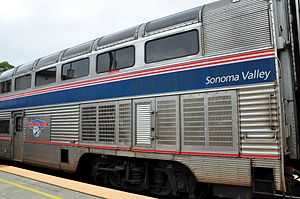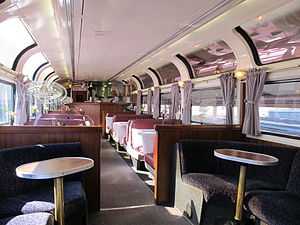Hi-Level
| Hi-Level | |
|---|---|
|
Exterior of the Amtrak Pacific Parlour Car "Sonoma Valley." | |
|
The interior of an Amtrak Pacific Parlour Car, a refurbished lounge. | |
| In service | 1954–present |
| Manufacturer | Budd Company |
| Constructed | 1954–1964 |
| Entered service | 1954 |
| Number built | 73 (61 coaches, 6 lounges, 6 diners) |
| Number in service | 5 (Amtrak) |
| Number preserved | Various in private ownership |
| Specifications | |
| Car length | 85 feet (26 m) |
| Height | 15 feet 6 inches (4.72 m) |
| Weight | 79.5 short tons (72.1 t) |
| Notes | |
| [1] | |
The Hi-Levels are a fleet of bilevel intercity railroad passenger cars built by the Budd Company for the Atchison, Topeka and Santa Fe Railway in the 1950s and 1960s. The first two coaches entered service on the El Capitan in 1954 and were an immediate success. Budd built sufficient coaches, dining cars, and lounge cars to fully reequip the El Capitan, with additional coaches seeing use on the San Francisco Chief. Despite plans no Hi-Level sleeping cars were ever produced. Amtrak inherited much of the Santa Fe's Hi-Level fleet in 1971 and continued to use the equipment on its western routes. In 1979 the first Superliners, based on the Hi-Level concept though built by Pullman-Standard, began entering service. As of 2013 Amtrak continues to operate five Hi-Level lounges, which it calls the "Pacific Parlour Cars", on the Coast Starlight.
Design
The Hi-Levels were 15.5 feet (4.7 m) high, 2 feet (0.61 m) taller than most conventional equipment. The additional space allowed for the entire upper level to be given over to seating, with restrooms, baggage, and other non-revenue areas on the lower level. The coaches could carry either 68 or 72 passengers, over the 44 of comparable single-level long-distance coaches. Each dining car seated 80 (all on the upper level), compared to 36 in a single-level diner. The lounges could seat 60 on the upper level, with additional seating on the lower level. This increased capacity permitted the Santa Fe to run the El Capitan with fewer cars while increasing the total number of passengers carried.[2]:138–241 In all three configurations the staircase between the two levels was located in the center of the car. The 68-seat coaches featured "step down" stairs at one end to permit access to standard-height equipment.[3] The original cars cost US$275,000 apiece.[1]
History
The Budd Company delivered the Hi-Levels in three batches. The original two prototype coaches (#526–527) entered service on the El Capitan in 1954. Following a positive customer response the Santa Fe ordered 47 more cars: 10 68-seat "step down" coaches (#528–537), 25 72-seat coaches (#700–724), 6 lounges (#575–580) and 6 dining cars (#650–655). These constituted five equipment sets, sufficient for daily service on the El Capitan beginning on July 8, 1956. The Santa Fe ordered an additional 24 coaches in 1963–1964 for use on the San Francisco Chief; 12 step-down (#538–549) and 12 not (#725–736).[3][4]:153 The Santa Fe also converted six single-level baggage cars to baggage-dormitories (#3477–3482) with a spoiler at one end to create a visual transition.[5]:166
The Hi-Level equipment continued in service under Amtrak beginning in 1971.[6]:129 Most were rebuilt with Head-end power (HEP) as part of the Heritage Fleet. Amtrak used the Hi-Levels as the basis for the design of Superliners it ordered from Pullman-Standard, which began arriving in 1978.[7]:57 In the 1980s many of the coaches were rebuilt as dormitory-coaches, with half the car given over to crew space. Several Hi-Level coaches remained in service into the 2000s on the Heartland Flyer.[8]:139
Amtrak's most prominent Hi-Levels are the so-called "Pacific Parlour Cars," which are the original Hi-Level lounges. Amtrak refurbished five of the six lounges for use on the Coast Starlight as sleeping car passenger only lounges.[8]:140
References
- ↑ 1.0 1.1 White, John H. (1985) [1978]. The American Railroad Passenger Car. Baltimore, MD: Johns Hopkins University Press. pp. 195–196. ISBN 0801827434. OCLC 11469984.
- ↑ Griswold, Wesley S. (January 1957). "Riding the Santa Fe's Split-Level Train". Popular Science: 136–139; 240–241.
- ↑ 3.0 3.1 Wayner, Robert J., ed. (1972). Car Names, Numbers and Consists. New York: Wayner Publications. pp. 196–197. OCLC 8848690.
- ↑ Wegman, Mark (2008). American Passenger Trains and Locomotives Illustrated. Minneapolis, MN: Voyageur Press. ISBN 9780760334751. OCLC 192109816.
- ↑ Simon, Elbert; Warner, David C. (2011). Amtrak by the numbers: a comprehensive passenger car and motive power roster, 1971-2011. Kansas City, MO: White River Productions. ISBN 978-1-932804-12-9. OCLC 837623640.
- ↑ Solomon, Brian (2004). Amtrak. Saint Paul, MN: MBI. ISBN 0-760-31765-8. OCLC 56490949.
- ↑ Schafer, Mike; Joe Welsh (1997). Classic American Streamliners. Osceola, WI: MotorBooks International. ISBN 0-7603-0377-0. OCLC 37281634.
- ↑ 8.0 8.1 Yenne, Bill (2005). Santa Fe Chiefs. Saint Paul, MN: MBI. ISBN 0760318484. OCLC 60557521.
External links
| Wikimedia Commons has media related to Hi-Level passenger cars. |
| ||||||||||||||||||
| ||||||||||||||||||||||||||||||||||||||||||||
| ||||||||||||||||

